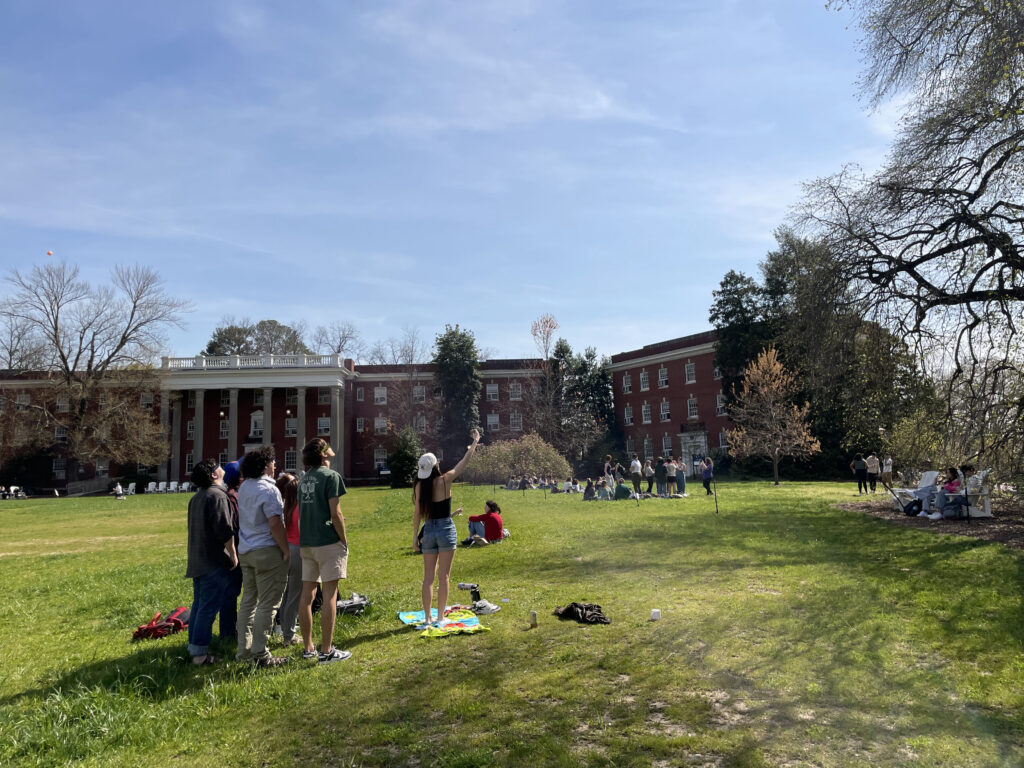Under the dark side of the moon: Students pleasure in warm weather and dream-like ambiance during eclipse
4 min read
Students and faculty alike gathered on Ball Circle and surrounding areas to experience the eclipse at its peak. Norah Walsh | The Weekly Ringer
by HALEY HEFLIN
Staff Writer
On the afternoon of April 9, the first total solar eclipse since 1979 arced across North America, though in Fredericksburg, Va. only a partial eclipse was visible. Nonetheless, students at UMW emerged on the bricks of Campus Walk and repopulated Ball Circle to its former glory. Students brought out picnic blankets, friends came together and classes were skipped, canceled or delayed. As the peak of the partial eclipse approached at 3:19 p.m., the energized Eagle community donned their protective glasses and shared their shades with students who wished to catch a glimpse.
According to NASA, “a solar eclipse occurs when the moon passes between the sun and the Earth, casting its shadow on the Earth’s surface.” The eclipse results in either partial or total darkness—depending on the viewer’s location within the eclipse’s path—and this alignment causes the moon to obscure or partially block the sun’s light, resulting in a temporary dimming or darkening of the sky.
While solar eclipses are not rare events, their frequency varies depending on the type of eclipse. On average, a total solar eclipse happens somewhere on Earth approximately every 18 months, and eclipse seasons—during which solar eclipses are more likely—happen approximately twice a year due to the slight tilt in the moon’s orbit relative to Earth’s orbit around the sun.
But the picture of students frolicking on Ball Circle and meandering around Campus Walk was a rare sight. Although only partial, the eclipse brought the community together—a sentiment that’s been lacking since the COVID-19 pandemic—creating an uplifting and vibrant scene to behold.
“It’s giving college and I kinda like it,” said sophomore psychology major Haylee Saddler as she sat on Ball Circle with friends, peering up at the eclipse.
Observing solar eclipses requires caution, as direct exposure to the sun’s rays can cause eye damage or blindness, so specialized equipment, such as solar eclipse glasses or pinhole cameras, must be used to view these phenomena safely.
“During the eclipse, with the glasses on, you couldn’t see the sun [for it was] almost as if it disappeared. It only showed the moon that was in front of the sun,” said sophomore Izzy Aversa. “If you did not have the glasses you couldn’t see the eclipse happening, you could only visualize the darkness happening around you.”
While most big brands like Walmart and Target had sold out of glasses, various buildings and offices on campus were handing out protective equipment for free leading up to the eclipse. For example, students could find glasses in the Student Activities and Engagement office, Admissions, and outside of Dodd Auditorium in George Washington Hall.
“My friends and I went out to Dodd Auditorium to grab a pair of eclipse glasses and viewing squares that were handed out for free, and for once most of the population at UMW was outside viewing the eclipse on Ball Circle,” said Grace Wagner, a freshman communication and digital studies major. “It was really cool being able to see everyone finally come together, and witness everything together on campus.”
The duration of a solar eclipse is a fleeting but unforgettable moment in time, making it a truly remarkable celestial event to witness. In the past, solar eclipses have had cultural and historical significance, with many ancient civilizations attributing mystical or divine meanings to these phenomena. Today, solar eclipses present valuable educational opportunities for students and the public alike.
George Washington Hall’s roof was open to the community to view the eclipse from a more elevated location; however, there was a limited occupancy of approximately 40 people allowed up at once. On the other side of campus, students and professors gathered outside the Jepson Science Center where the physics department had set up a telescope for a more enhanced view.
The eclipse presented an unusual visual change as the environment darkened but traces of sunlight were still visible. The sun’s rays, once extremely vibrant, dulled down, and the light shed onto Earth created an ambiance that almost felt like a dream. As a result of the sun being covered—at least partially—the air cooled down and one of the first warm days of the semester was covered in a slight chill.
“I had forgotten how much the temperature changed as a result of the eclipse,” said Matthew Fleenor, a physics professor and program coordinator. “In 2017, we were running an outreach event in the path of totality, so this was a bit different, but there’s no place I would have rather been than with Mary Wash students.”
Norah Walsh and Charlie Li contributed to reporting for this article.










